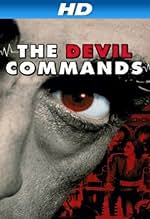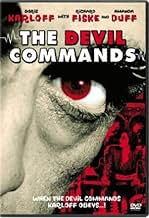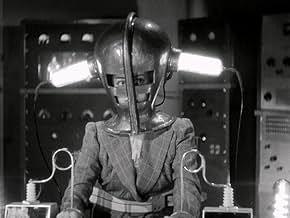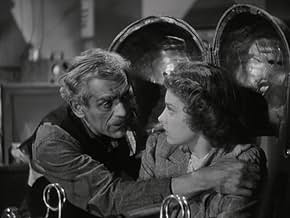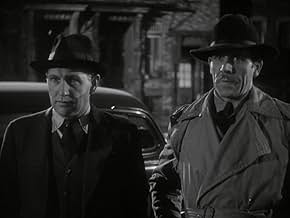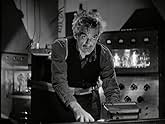NOTE IMDb
6,1/10
1,6 k
MA NOTE
Ajouter une intrigue dans votre langueScientist becomes obsessed with the idea of communicating with his dead wife.Scientist becomes obsessed with the idea of communicating with his dead wife.Scientist becomes obsessed with the idea of communicating with his dead wife.
- Réalisation
- Scénario
- Casting principal
Ernie Adams
- Elam
- (non crédité)
Lester Allen
- Dr. Van Den
- (non crédité)
Wheaton Chambers
- Dr. Sanders
- (non crédité)
Earl Crawford
- Johnson
- (non crédité)
Harrison Greene
- Mr. Booth, Bakery Proprietor
- (non crédité)
Erwin Kalser
- Professor Kent
- (non crédité)
Eddie Kane
- Professor Walt
- (non crédité)
George McKay
- Station Agent
- (non crédité)
Al Rhein
- Truck Driver
- (non crédité)
Avis à la une
Corny and cliche'd as The Devil Commands may look to the superficial gaze, it's a powerful expression of the inextinguishable and far from trivial human wish to believe that death is not the end and that the dead we loved are not forever lost to us. Karloff starred in a whole sub-genre of films on this theme from the middle 1930s to the early 1940s (cf The Invisible Ray, Before I Hang, The Man They Could Not Hang, etc), invariably as a misunderstood scientific genius, embittered by tragedy or injustice, whose desire to conquer death clashes fatally with the prerogatives of the Almighty.
Whether one believes in an afterlife or not, it would be a coarsely reductionist mind that could consider the subject ridiculous. What gives these films (and this one in particular) their eerily modernist slant on the matter lies in the way they reflect the public's awe of science in the first half of the twentieth century, when astonishing developments such as radio and television (and that weird form of immortality, the motion picture), made it seem believable that technology might solve the supernatural as well as the physical mysteries. It is worth remembering in this context that the contemporary electrical wizards Thomas Edison and Nikola Tesla, classical Mad Scientists both, attempted to build machines with which to talk to the dead.
In this morbidly obsessive cinematic byway The Devil Commands stands out as one of the most insidiously poignant and nearly blasphemous films of its kind, sailing very close to the emotional and spiritual wind in its depiction of Karloff's bizarre attempts to communicate with his dead wife. As a mad-scientist entertainment it contains some of the most magnificently deranged laboratory scenes ever filmed, surpassed in this context only by James Whale's Frankenstein and Bride Of Frankenstein. I still succumb to its mournful fascination. And if your first viewing doesn't scare you half to death, you can't be more than half alive.
Whether one believes in an afterlife or not, it would be a coarsely reductionist mind that could consider the subject ridiculous. What gives these films (and this one in particular) their eerily modernist slant on the matter lies in the way they reflect the public's awe of science in the first half of the twentieth century, when astonishing developments such as radio and television (and that weird form of immortality, the motion picture), made it seem believable that technology might solve the supernatural as well as the physical mysteries. It is worth remembering in this context that the contemporary electrical wizards Thomas Edison and Nikola Tesla, classical Mad Scientists both, attempted to build machines with which to talk to the dead.
In this morbidly obsessive cinematic byway The Devil Commands stands out as one of the most insidiously poignant and nearly blasphemous films of its kind, sailing very close to the emotional and spiritual wind in its depiction of Karloff's bizarre attempts to communicate with his dead wife. As a mad-scientist entertainment it contains some of the most magnificently deranged laboratory scenes ever filmed, surpassed in this context only by James Whale's Frankenstein and Bride Of Frankenstein. I still succumb to its mournful fascination. And if your first viewing doesn't scare you half to death, you can't be more than half alive.
BORIS KARLOFF is a scientist who wants to communicate with the brain waves of his dead wife. His daughter narrates the tale and concludes with: "It is dangerous to communicate with the dead." That's about the impression the viewer gets after seeing what happens in the course of a brisk one hour and six minutes.
Columbia produced this low-budget feature and gave the directing chores to Edward Dmytryk, who would later go on to bigger and better things at RKO. But it's an efficient thriller thanks to his direction and the low-key, shadowy photography that makes the absurd story at least come to life on occasion.
Enjoyable too are the performances of ANN REVERE as a sinister housekeeper who knows all about Karloff's experiments and what goes on behind the locked doors of his laboratory; DOROTHY ADAMS as an inquisitive servant who agrees to check out the lab and gets locked inside; and KENNETH MacDONALD as the Sheriff determined to find out who is responsible for all the missing bodies from the graveyard.
It's typical Karloff stuff and he lends his commanding presence to the role with more dignity than it deserves. If it emerges as a better than average horror vehicle, it's because director Dmytryk is at the helm, but the script is absurd. The low-budget production values are neatly hidden by all the shadowy photography.
Columbia produced this low-budget feature and gave the directing chores to Edward Dmytryk, who would later go on to bigger and better things at RKO. But it's an efficient thriller thanks to his direction and the low-key, shadowy photography that makes the absurd story at least come to life on occasion.
Enjoyable too are the performances of ANN REVERE as a sinister housekeeper who knows all about Karloff's experiments and what goes on behind the locked doors of his laboratory; DOROTHY ADAMS as an inquisitive servant who agrees to check out the lab and gets locked inside; and KENNETH MacDONALD as the Sheriff determined to find out who is responsible for all the missing bodies from the graveyard.
It's typical Karloff stuff and he lends his commanding presence to the role with more dignity than it deserves. If it emerges as a better than average horror vehicle, it's because director Dmytryk is at the helm, but the script is absurd. The low-budget production values are neatly hidden by all the shadowy photography.
One of several "Mad Doctor" films Boris Karloff made for Columbia Pictures in the '40s and often considered one of the best of that group by many fans. It's not bad, but it's only a notch above average in my estimation. Here we have Karloff as a scientist who has discovered a device for reading people's brain waves and then becomes obsessed with the idea of trying to communicate with his recently deceased wife. He enlists the aid of a somewhat eccentric phony mystic (Anne Revere) who becomes the dominant force in the partnership and sets the course for some potentially disastrous events.
This movie was directed by Edward Dmytryk, so at least it enjoys some spirited dashes of mood and dreary lighting, which is one thing that elevates it just over the line of the ordinary. It's interesting to see long-time Three Stooges foil Kenneth MacDonald as a sheriff who suspects that strange goings-on are underfoot in Boris' mysterious house, and Anne Revere's stoic and power-hungry medium is an added benefit. Still, there's something which seems to be lacking here to keep this one from rising above "B" level. Karloff is quite good as the eager but harried scientist, emitting a range of different emotions during the course of the picture. **1/2 out of ****
This movie was directed by Edward Dmytryk, so at least it enjoys some spirited dashes of mood and dreary lighting, which is one thing that elevates it just over the line of the ordinary. It's interesting to see long-time Three Stooges foil Kenneth MacDonald as a sheriff who suspects that strange goings-on are underfoot in Boris' mysterious house, and Anne Revere's stoic and power-hungry medium is an added benefit. Still, there's something which seems to be lacking here to keep this one from rising above "B" level. Karloff is quite good as the eager but harried scientist, emitting a range of different emotions during the course of the picture. **1/2 out of ****
I saw this movie over 35 years ago, as a child, late at night.It left a big impression on me and scared me to death. I recently saw it again and my earlier impressions were justified. Karloff tries to contact the soul of his dead wife using an apparatus comprised of metal helmets through which he directs psychic electricity. The whirling vortex of soul energy is a high point in the film. Karloff gets more and more creepily deranged as the movie goes on. Presumably the devil makes him do it. This film is really a well done minor gem. Fans of the mad scientist/laboratory genre will find much to enjoy. This film is a must for Karloff afficianados. It is unfortunately very difficult to find as it hasn't been on T.V.for years and no commercial video tapes exist. See it if you can!
Kindly Dr. Revere (Boris Karloff) has found a way to record the brain waves of people. His loving wife is tragically killed in a car accident. Revere however gets a reading from his dead wife (he thinks) when alone in is lab. He becomes obsessed with trying to communicate with her beyond the grave. He ends up with a cruel conniving fake medium (Anne Revere) and some corpses borrowed from the nearby cemetery.
OK--the plot doesn't make a lick of sense. He does turn on the machine after his wife dies and he DOES get a message--but how can he know it's her? Why does he need to use other dead bodies to communicate with his wife? Why not dig up HER body and try it? Too many questions. The sets are threadbare (looks more like a PRC production than Columbia), talented character actress Revere gives out her worse performance, the silly narration doesn't work and it just completely derails at the end. Still Karloff is good (as always) and gives this junk a better performance than it deserves. He single handedly makes this an OK movie. It just isn't that scary. It does have a somewhat spooky scene where a maid is stuck in a room with a bunch of dead bodies but that's it. Minor but a must for Karloff fans.
OK--the plot doesn't make a lick of sense. He does turn on the machine after his wife dies and he DOES get a message--but how can he know it's her? Why does he need to use other dead bodies to communicate with his wife? Why not dig up HER body and try it? Too many questions. The sets are threadbare (looks more like a PRC production than Columbia), talented character actress Revere gives out her worse performance, the silly narration doesn't work and it just completely derails at the end. Still Karloff is good (as always) and gives this junk a better performance than it deserves. He single handedly makes this an OK movie. It just isn't that scary. It does have a somewhat spooky scene where a maid is stuck in a room with a bunch of dead bodies but that's it. Minor but a must for Karloff fans.
Le saviez-vous
- AnecdotesCompleted December 1940, released February 3, 1941.
- GaffesDr. Julian tells Mrs. Walters she had 10,000 volts pass through her body. Volts do not flow or pass, amps do.
- Citations
Dr. Julian Blair: Anne dear, your mother is not dead, not really. She's come back to me!
- ConnexionsFeatured in Hollywood and the Stars: Monsters We've Known and Loved (1964)
Meilleurs choix
Connectez-vous pour évaluer et suivre la liste de favoris afin de recevoir des recommandations personnalisées
- How long is The Devil Commands?Alimenté par Alexa
Détails
- Durée
- 1h 5min(65 min)
- Couleur
- Rapport de forme
- 1.37 : 1
Contribuer à cette page
Suggérer une modification ou ajouter du contenu manquant


